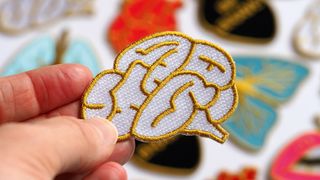Stefan Sagmeister
" I'm looking for an emotional response that comes less from idea-based work and more from formal, visceral and style-based designs." Garrick Webster speaks to the influential Stefan Sagmeister.
From West 14th Street in New York, Sagmeister Inc's studio overlooks the exciting cityscape of Manhattan. From this office, the Austrian-born graphic designer Stefan Sagmeister sends 100 greetings to all his clients and contacts at the end of each email he sends. More important is the influence he seems to transmit across the industry with the projects he works on.
It's fair to say that his ideas have had a rippling effect throughout design since the mid-1990s. From record sleeves to annual reports and perfume packaging, his output mixes visceral directness and intelligence. His indulgences, shock tactics and forthright opinions will always be questioned, but the thoughtfulness of his approach should not be overlooked.
For the first new-look issue of Computer Arts, we speak to the designer who famously put his own skin on the front line in the name of design, to find out what drives his creativity.
CA: Stefan, you've been credited with bringing to the fore an era of handmade design, which has become very popular. You'll even see handmade lettering on eBay's homepage. What do you think of this, and how would you characterise your own approach to design?
SS: In the early 90s, when the modernism revival started and many designers opted for cold, slick design, it seemed a natural reaction for us to go the other way. My feeling was that so many viewers are left untouched by the machine-like visuals out there that a more human approach seemed a smart alternative. In the meantime, with companies using hand-scratched headlines for their advertising, such as IBM, this strategy has lost much of its meaning.
CA: Some of your work - forming text from pieces of intestine, a man vomiting, letters carved on your body - is described as unsettling, even dark. How important is the visceral response, and how far would you go?
SS: Considering that as designers we often have a viewer's attention for only a couple of seconds, any response that can be elicited in such a short time - shock at one end of the spectrum and humour at the other - is welcome, as long as it makes sense within the context of the project.
I'd go as far as 11th Avenue, but not further. The Hudson is so cold this time of the year.
CA: There's a psychology in all of this: how important is aiming for an emotional response compared with a rational response in today's design?
SS: It completely depends on the project. But as I get older, I'm more and more looking for an emotional response that comes less from idea-based work and more from formal, visceral and style-based designs. Idea-based work tends to be jokey or witty, which likely becomes a drag once you get it.
CA: I saw a comment on your website saying that branding is overrated, outdated crap. Yet, nearly everywhere, the thinking is that brand is the most important thing. Can you tell me more about your views on the relative importance of branding?
SS: Most international branding agencies overrate their power and influence by a magnitude. As much as they would like to insist otherwise, in everyday life their work has a small impact on the actual service or product their clients provide or manufacture. But by far the biggest impact on the perception of a brand is the quality of that service or product. There are a couple of exceptions, fields where the consumer can't tell the difference between products, say vodka or water, but in general the consumer is smarter than they paint her.
CA: Do you feel computers have made all mainstream design look too similar?
SS: I think many designers get lost within the incredible, endless possibilities of the computer. Because it can do so much, we are often overwhelmed by the choices and there is the danger that we take the easy way and do what is easiest, and consequently get stuck with some silly, multilayer Photoshoppy look. Brian Eno acknowledged in an interview that the electric guitar became the dominant instrument of the 20th century because it's such a stupid instrument that can do so little, thus encouraging players to go to the edge of its possibilities.
CA: I understand you have a small team at Sagmeister Inc. How many of you are there, who are your colleagues and why do you favour this close-knit approach?
SS: We are three designers: myself, Joe Shouldice and Richard The, and one intern. I keep the studio small because:
1 We have no bureaucracy, so can act quickly and efficiently, and there are very few misunderstandings, wrong briefs or fake jobs - problems that are so prevalent at larger companies.
2 We can only do a small proportion of the jobs we're offered, allowing us to pick and choose from those.
3 We have small overheads, so can remain financially independent from our clients.
4 Everything I've ever seen that was any good in design was developed by a small team (even if it came out of a big company). If five or more people were involved, it's always crap.
5 Fun.
CA: Do you think that the big agencies in the creative world are losing touch?
SS: There are design projects where a large team is necessary, say car design or hardware design. Graphics are best developed by a small team. I can't think of a single large design company I admire. The closest would be Pentagram, but then they are many small companies under one roof. And Landor does some good work every once in a while.
CA: What's the most important project you've worked on lately?
SS: By far the most interesting project I have been involved in in recent years is a series of typographic works that came out of a list I found in my diary under the title 'Things I Have Learned In My Life So Far'. Every one of these pieces has been published. So far they have appeared as French and Portuguese billboards, a Japanese annual report, on German television, in Austrian magazines, as a New York direct mailout and in an American poster campaign.
The series was influenced by my grandfather, who was educated in sign painting. I grew up with many of his pieces of his wisdom around the house. It was also influenced by the American artist Jenny Holzer as well as the rustic wooden signs available in tourist stores all over my hometown of Bregenz in Austria.
The book features 16 individual booklets of 16 pages each, inserted into a die-cut slipcase, allowing for 16 different covers in the bookstore and infinite variations in the reading experience.
CA: Which other creative people have you found inspiring during your career?
SS: Tibor Kalman has always been a big influence and now his wife Maira has taken on that role. I love the Canadian typographer Marian Bantjes, American designer Rick Valicentia..oh, oops, that's four already.
CA: In some circles designers are thought of as being in a powerful position in society. However, you have said that this power is actually quite limited.
SS: Martin Guix rightly pointed out a while ago that if your aim is to change the world, the most efficient profession to do this in is politics, not design.
CA: Do you think designers have any special responsibility, and if so what does it entail?
SS: Just like in any other profession, you have a responsibility to do your job well. And you should have fun doing it and not harm others while doing so.
CA: What did you have for your breakfast this morning?
SS: Three espressos.

Thank you for reading 5 articles this month* Join now for unlimited access
Enjoy your first month for just £1 / $1 / €1
*Read 5 free articles per month without a subscription

Join now for unlimited access
Try first month for just £1 / $1 / €1
Get the Creative Bloq Newsletter
Daily design news, reviews, how-tos and more, as picked by the editors.
The Creative Bloq team is made up of a group of design fans, and has changed and evolved since Creative Bloq began back in 2012. The current website team consists of eight full-time members of staff: Editor Georgia Coggan, Deputy Editor Rosie Hilder, Ecommerce Editor Beren Neale, Senior News Editor Daniel Piper, Editor, Digital Art and 3D Ian Dean, Tech Reviews Editor Erlingur Einarsson and Ecommerce Writer Beth Nicholls and Staff Writer Natalie Fear, as well as a roster of freelancers from around the world. The 3D World and ImagineFX magazine teams also pitch in, ensuring that content from 3D World and ImagineFX is represented on Creative Bloq.




